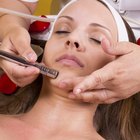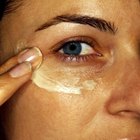
Photofacials turn back time, at least from the perspective of your skin. Using a series of light pulses emitted over various wavelengths, photofacials make skin appear younger. The treatments reduce the visible effects of sun damage; improve the appearance of acne scars, large pores and dark circles around the eyes; and reduce fine lines and wrinkles. The procedure is convenient, the results are immediate and no hospitalization is required, but there are some serious risks involved.
Increased Redness
While photofacials generally make skin look better, the treatment can do the opposite for some patients, Nutra Legacy reports. Photofacials can make skin appear older, enlarge pores, break blood vessels, increase the visibility of small capillaries and actually increase, rather than reduce, skin redness.
Pigmentation Changes
Decreased pigmentation can be seen, particularly if your skin has a tan. This is known as "foot-printing" and occurs when the photofacial treatment strips the skin of its top layer of color. Hyper-pigmentation, or darkening of the skin, has also been reported. Greeks, Italians, Native Americans and African Americans are most prone to these side effects.
Skin Blisters and Swelling
Photofacials can cause blistering and bruising of the skin. In addition, the facial skin may fill with fluid. Face swelling after a photofacial treatment is common, particularly in severely sun-damaged skin because of damage to the connective tissues around the blood vessels.
Infections
Photofacials can cause skin infections and create wounds. For this reason, insulin-dependent diabetics cannot be treated with photofacials. In rare cases, bleeding and even scarring has been reported. Many of these side effects are seen on dark-skinned or darkly tanned people, or on those who easily burn.
Related Articles

Side Effects From Skin Tightening

How to Remove Dark Marks From Skin

How to Shave Skin Moles

Fraxel Laser Treatment Dangers

Hyperpigmentation and Shaving

List of Retinoids

Homeopathy Cure for Stretch Marks

Fraxel Repair Vs. Restore Results

Negative Effects of Endermologie

Jojoba Oil Benefits

The Best Facial Moisturizers for People ...

Can LED Light Get Rid of Brown Spots on ...

How to Get Rid of Acne Dents

Removing Acne Scars With Tretinoin Cream

What Are the Dangers of Fraxel Repair?

Risks of Facial Fillers

Face Abrasion Treatment

Review of New-Skin Scar Therapy

How to Make a Mustache Shadow Go Away

How to Lighten Birthmarks
References
Writer Bio
Robin Wasserman has been writing and prosecuting biochemical patents since 1998. She has served as a biochemical patent agent and a research scientist for a gene-therapy company. Wasserman earned her Doctor of Philosophy in biochemistry and molecular biology, graduating from Harvard University in 1995.
Photo Credits
facial neon sign image by Karin Lau from Fotolia.com